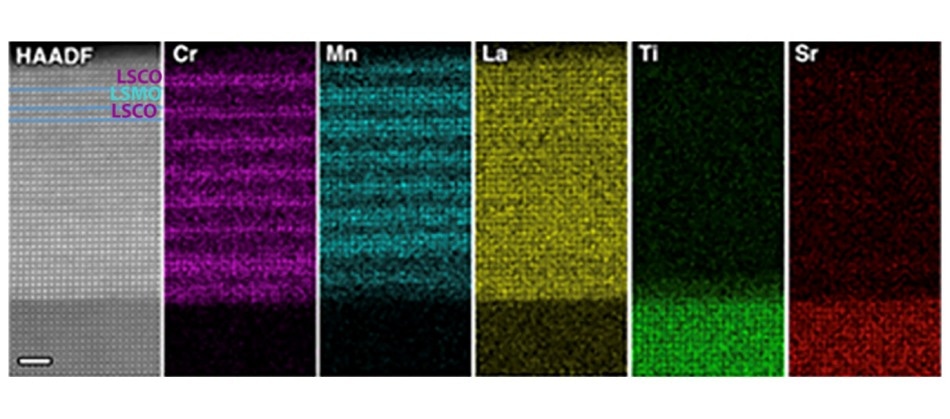Jun 12 2019
Scientists from North Carolina State University have discovered that the oxide ceramic material lanthanum strontium manganite (LSMO) holds its magnetic properties in atomically thin layers upon being “sandwiched” between two layers of a dissimilar ceramic oxide, lanthanum strontium chromium oxide (LSCO).
 Atomic-scale structure obtained by high-resolution electron microscopy. (Image credit: North Carolina State University)
Atomic-scale structure obtained by high-resolution electron microscopy. (Image credit: North Carolina State University)
The study outcomes have inferences for the potential use of LSMO in spintronic-based computing and storage devices.
When LSMO is in bulk form, it has magnetic as well as metallic properties. By modifying its magnetic field, the conductivity of the material can be changed, which renders LSMO attractive for use as a switch in spintronic devices. However, when the material reaches a particular thickness—between 5 and 10 atomic layers—it loses these properties.
Divine Kumah, assistant professor of physics at NC State and corresponding author of a paper explaining the research, intended to know why LSMO loses its magnetic properties at a specific thickness and to find a method to produce LSMO magnetic in thin form.
Kumah, with teammates and graduate students from NC State, first developed thin films of LSMO on strontium titanate, a non-magnetic substrate widely employed as a neutral scaffold. The group developed films with thickness in the range of 2 to 10 atomic layers and tested them for magnetic properties.
After that, the research group made use of the synchrotron light source at Argonne National Laboratory so that they could have a 3D view of the arrangement of atoms inside the thin layers of LSMO. They identified that at extreme thickness, the manganese and oxygen atoms are somewhat moved out of alignment on the surface of the material, thereby switching off its magnetism.
At about five atomic layers we saw distortions on the surface of the layer and at the bottom interface with the scaffold. The oxygen and manganese atoms rearrange themselves. Magnetism and electrical conductivity in LSMO are related to how these two atoms bond, so if there are polar distortions in the film where they move up and down, the bonds stretch out, electrons can't move through the material effectively and magnetism is switched off.
Divine Kumah, Assistant Professor of Physics, North Carolina State University
The group observed that these distortions were initiated at the top of the film and reached around three layers below the surface.
“We found that the distortions occur because the crystal structure creates an electric field at the surface,” stated Kumah. “The oxygen and manganese atoms move in order to cancel the electric field. Our challenge was to grow something at the interfaces that is compatible with LSMO structurally but that is also insulating—so that we remove the electric field, stop the movement of the oxygen and manganese atoms and retain magnetic properties.”
The scientists found that by sandwiching LSMO between two layers of LSCO, the LSMO could save its magnetic properties at two atomic layers.
“It is like a sandwich—LSCO is the bread and LSMO is the meat,” stated Kumah. “You can use fewer than five layers of LSMO in this arrangement without any atomic displacement. Hopefully our work has shown that these materials can be thin enough to be useful in spintronics devices.”
The study has been reported in npj Quantum Materials and is supported by the National Science Foundation and the Department of Energy. NC State PhD student Sanaz Koohfar is the first author. NC State graduate student Aubrey Penn, and James LeBeau, associate professor of materials science, along with Alexandru Georgescu of the Flatiron Institute and Elke Arenholz of Lawrence Berkeley National Laboratory also contributed to the study.